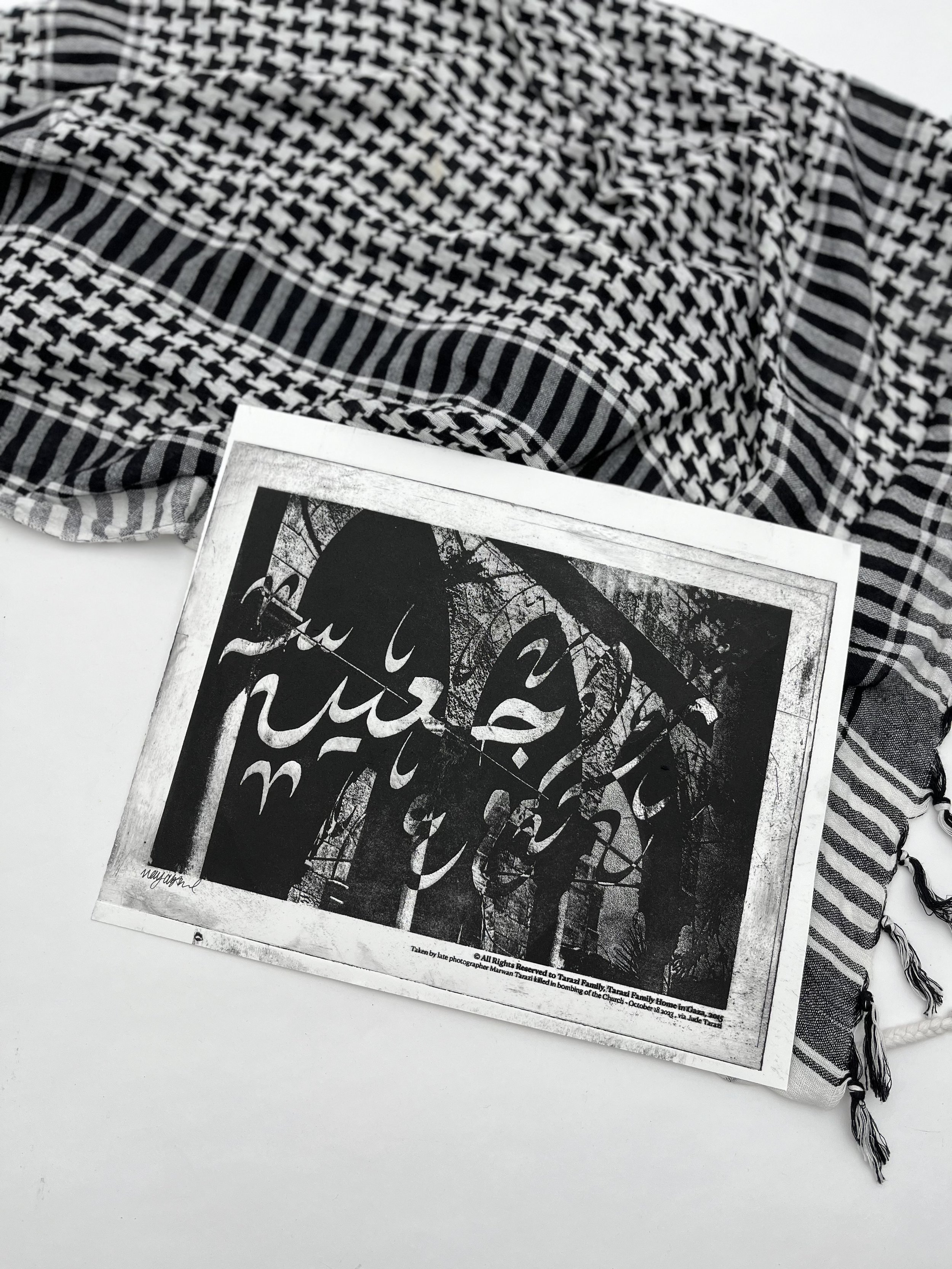London: Printing for Palestine
With the on-going bombardment of Gaza, BA Graphic Design students Nayab Ahmed and Jude Tarazi decided to create prints to fundraise for the cause.
Nayab Ahmed and Jude Tarazi on their Project
“I never thought that when I first picked up a brush and used the Arabic script to express beauty in the world that I was doing anything profound. But recently, I have felt this responsibility in showing the beautiful non-political side to the Arabic script in my design practice and using it as powerful tool to stand up for issues I believe in.” - Nayab Ahmed
Image courtesy of Nayab Ahmed, 2024.
“My aim really was to use my Calligraphic skill and print design to create awareness to go toward a greater cause through the donation. These are a tribute to the devastating destruction of the Tarazi family home as well as to the millions of Palestinians within and throughout the diaspora, who have been affected.” - Nayab Ahmed
Image courtesy of Nayab Ahmed, 2024.
“Through the process of creating this outcome, I've come to realise that it serves as a powerful tool for promoting empowerment and activism. I've had the opportunity to articulate the significance of the artwork and share its message across various media platforms, particularly during such crucial times. By advocating for this piece and its true meaning, I've been able to voice my opinions, stand up for what is right, and amplify the emotions deeply tied to my family's experiences and the profound importance of Palestine, Gaza, and Home to me. It has been immensely rewarding to witness others appreciate and understand the true essence of the piece.” - Jude Tarazi
Image courtesy of Nayab Ahmed, 2024.
Jude Tarazi on her Family History and Design
The core objective of this project was rooted entirely in my desire to provide a platform for the appreciation of my Great-Grandfather's house, celebrating its rich history, cherished memories, and profound significance to the entire Tarazi Family. My goal was to convey that this house embodies a pivotal moment in history, a sentiment I believe I've successfully achieved through the diverse prints created. These prints authentically showcase the special place this house holds within Gaza, Palestine.
This artwork comprises three components: an image/photograph, the song choice "Rajeen" (which translates to "Return"), and an etching print.
The House of Tarazi in Gaza city, Sabra, was built in 1926 by my late Great Grandfather Khader Tarazi and his wife Melvina Tarazi, who married in 1922. Khader Tarazi was born in 1890. With his wife, Khader Tarazi had seven children: two girls and five boys. My grandfather Raja Tarazi built his own home after his marriage just behind the Tarazi home. My father, Ramzi Tarazi, always tells me stories about how they would run across the fields, known as the bayara, through the lemon, olive and orange trees, playing games and enjoying the freedom of being outdoors. They would jump over the back balcony of the main home to enter the kitchen and spend hours conversing and laughing with their uncles and aunts. The home had a central common area that branched into seperate bedrooms and lounges. There was always room for everyone to stay including children, grandchildren and cherished friends and neighbours. The smell of the jasmine as you enter through the main front garden always lifted the spirits particualry when you would find everyone gathered in the afternoon chatting on the main front balcony ready to welcome everyone in. The home is no longer there and what is left are these memories and photos. Whilst it pains to see such destruction of distinguished architecture, as a family of many generations to come the memories can not be destroyed and stories of what was there will remain. This image is true anchoring of this strong will to preserve, remember, reconstruct and return.
The song "Rajeen" ("Return") has been a profound emotional anchor for me over the past six months. It eloquently encapsulates the ongoing conflict, asserting the enduring strength of Palestinians, our unwavering connection to our homeland, and our resolve to reclaim it. It transcends boundaries, embodying resilience and resistance. Its lyrics resonate deeply with the sentiments I've experienced during this time, underscoring our collective pride as Palestinians. While the song carries profound meaning on its own, pairing it with images of my great-grandfather's house enhances its significance, filling me with pride for the artwork created.
We believed that etching this print would effectively highlight the various elements of the house, including its architecture, the calligraphy adorning the walls, and the overall significance of the image. Our aim was to craft a piece that required dedication and effort to convey the messages embodied by the house. Producing tangible outcomes allowed individuals to acquire prints that they could display or collect as meaningful pieces of art. It was truly gratifying to witness people appreciating the artwork created and being able to personally possess it as a representation of its history.



